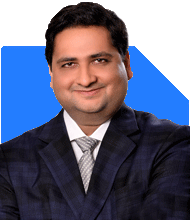How should a 31-year-old with 1.25 lacs monthly income invest 50,000 per month?
Ramalingam Kalirajan |10893 Answers |Ask -Follow
Mutual Funds, Financial Planning Expert - Answered on Oct 07, 2024
He has an MBA in finance from the University of Madras and is a certified financial planner.
He is the director and chief financial planner at Holistic Investment, a Chennai-based firm that offers financial planning and wealth management advice.... more

I am 31years old. I have a appartment and a car in my name. No loan till date. My earni gs are 1.25 lacs per month. I wanted to invest for my future. I can spare 50000 per month. Would like to have your advice
With Rs 50,000 available each month for investments, you have a fantastic opportunity to grow your corpus over time. Let’s delve into how you can effectively allocate your funds to ensure a balanced and prosperous future.
Why Avoid Real Estate?
Real estate can sometimes seem like a lucrative investment. However, it is essential to understand that real estate investment comes with various challenges and considerations:
High Capital Requirement: Real estate typically requires significant capital. This can restrict your liquidity, leaving you without readily accessible funds in emergencies.
Market Fluctuations: Property values can fluctuate. You may not always see the desired returns when you need them.
Maintenance and Costs: Owning property often comes with additional costs such as maintenance, property taxes, and insurance. These can eat into your overall returns.
Time-Consuming: Managing real estate can be time-consuming. It requires constant oversight, whether it's dealing with tenants or maintaining the property.
Given your current financial status, it would be wise to focus your investments on more liquid and less risky avenues. This will allow you to grow your wealth effectively without tying up your capital.
Evaluating Investment Options
You have a significant amount, Rs 50,000, to invest each month. Let's assess the best investment avenues for you:
1. Mutual Funds
Mutual funds are one of the most effective ways to grow your wealth over time. They provide diversification, professional management, and liquidity.
Diversification: Investing in a mutual fund gives you access to a basket of stocks or bonds. This minimizes the risk of losing all your money if one investment does poorly.
Professional Management: With mutual funds, your money is managed by experts. They continuously analyze market trends and make investment decisions.
Liquidity: Mutual funds offer flexibility in terms of liquidity. You can redeem your investments when needed.
For your profile, actively managed equity funds are an excellent choice. These funds have the potential to outperform passive options over the long term.
Disadvantages of Index Funds
While index funds may seem appealing due to their lower expense ratios, there are significant disadvantages to consider:
Limited Growth Potential: Index funds aim to replicate market performance. They don’t actively manage or adjust investments based on market conditions. This means they might miss opportunities for growth.
No Personal Touch: Investing in an index fund means you are relying on the market as a whole. Active managers can adapt to changes and manage risk more effectively.
Actively managed funds can respond to changing market dynamics, aiming for higher returns. They have the flexibility to switch between stocks based on performance and market conditions.
2. Systematic Investment Plan (SIP)
A Systematic Investment Plan (SIP) allows you to invest a fixed amount regularly. This strategy has several advantages:
Rupee Cost Averaging: Investing a fixed amount regularly helps in averaging the cost of purchases. You buy more units when prices are low and fewer units when prices are high.
Discipline in Investing: A SIP encourages you to invest regularly, fostering a habit of saving and investing. This disciplined approach can significantly enhance your wealth over time.
Long-Term Growth: Equity markets tend to perform well over the long term. A SIP helps you stay invested, benefiting from compounding growth.
Consider allocating a significant portion of your Rs 50,000 monthly investment through SIPs in mutual funds. Aim for a mix of equity and hybrid funds, where equity funds focus on long-term growth, while hybrid funds offer stability.
3. Regular vs. Direct Funds
When investing in mutual funds, it’s crucial to understand the difference between regular and direct funds:
Regular Funds: These are sold through intermediaries, such as a Certified Financial Planner. They offer guidance and support, ensuring that your investments align with your financial goals. You benefit from their expertise in choosing the right funds.
Direct Funds: While direct funds have lower expense ratios, they often lack comprehensive support. You might miss valuable insights and recommendations without expert guidance.
Choosing regular funds allows you to access personalized advice. This can be beneficial for optimizing your investment strategy.
4. Public Provident Fund (PPF)
The Public Provident Fund (PPF) is another excellent investment option for you. It has several key advantages:
Safe Investment: PPF is backed by the government. It offers guaranteed returns, making it a safe choice.
Tax Benefits: Contributions to PPF qualify for tax deductions under Section 80C. The interest earned and maturity amount are also tax-free.
Long-Term Lock-In: PPF has a 15-year lock-in period. This encourages disciplined savings and reduces the temptation to withdraw early.
Consider contributing a portion of your monthly investment to PPF. The fixed returns and tax benefits make it an attractive option for wealth accumulation.
5. National Pension System (NPS)
The National Pension System (NPS) is an excellent long-term investment for retirement planning. Here are some benefits:
Retirement Savings: NPS helps you build a retirement corpus over the long term. This can provide financial security during your retirement years.
Tax Benefits: Contributions to NPS qualify for tax deductions. You can claim additional deductions beyond those available for PPF.
Flexible Investment Options: NPS allows you to choose from a mix of equity, corporate bonds, and government securities. This flexibility lets you tailor your investment strategy based on your risk appetite.
Allocate a portion of your monthly investment to NPS. This will help enhance your retirement savings and provide valuable tax benefits.
6. Diversifying Your Investments
Diversification is a key strategy in investment. It helps reduce risk while aiming for higher returns. Here's a suggested allocation for your Rs 50,000 monthly investment:
Equity Mutual Funds: Rs 30,000
This will allow you to capitalize on the growth potential of equity markets.
Public Provident Fund (PPF): Rs 10,000
This ensures a safe investment option with fixed returns.
National Pension System (NPS): Rs 10,000
This will strengthen your retirement corpus.
By spreading your investments across different avenues, you can balance growth with safety.
Importance of Regular Monitoring
Investing is not a one-time activity. It requires regular monitoring and adjustments. Here are some key points to consider:
Annual Reviews: Regularly review your portfolio to ensure it aligns with your goals. Adjust your investments based on performance and changing market conditions.
Stay Informed: Keep yourself updated on market trends, economic changes, and investment options. This knowledge will help you make informed decisions.
Seek Professional Guidance: Consult with a Certified Financial Planner for personalized advice. Their expertise can provide insights that enhance your investment strategy.
Final Insights
Investing wisely today will secure your financial future. Focus on mutual funds and NPS for a balanced approach.
Aim for a diversified portfolio that includes equity mutual funds, PPF, and NPS.
Keep track of your investments regularly and adjust as needed.
Stay informed about market trends and economic changes to make educated investment decisions.
Utilize the expertise of a Certified Financial Planner to optimize your investment strategy.
Taking these steps can help you build a solid financial foundation. By making informed investment choices, you will be well on your way to achieving your financial goals.
Best Regards,
K. Ramalingam, MBA, CFP,
Chief Financial Planner,
www.holisticinvestment.in
https://www.youtube.com/@HolisticInvestment
You may like to see similar questions and answers below
Omkeshwar Singh | Answer |Ask -Follow
Head, Rank MF - Answered on Sep 08, 2021
Hardik Parikh | Answer |Ask -Follow
Tax, Mutual Fund Expert - Answered on May 04, 2023
Sanjeev Govila | Answer |Ask -Follow
Financial Planner - Answered on Jan 23, 2024
Milind Vadjikar | Answer |Ask -Follow
Insurance, Stocks, MF, PF Expert - Answered on Nov 26, 2024
Ramalingam Kalirajan |10893 Answers |Ask -Follow
Mutual Funds, Financial Planning Expert - Answered on Jul 12, 2025
Ramalingam Kalirajan |10893 Answers |Ask -Follow
Mutual Funds, Financial Planning Expert - Answered on Dec 15, 2025
Ramalingam Kalirajan |10893 Answers |Ask -Follow
Mutual Funds, Financial Planning Expert - Answered on Dec 15, 2025
Radheshyam Zanwar |6746 Answers |Ask -Follow
MHT-CET, IIT-JEE, NEET-UG Expert - Answered on Dec 15, 2025
Ramalingam Kalirajan |10893 Answers |Ask -Follow
Mutual Funds, Financial Planning Expert - Answered on Dec 15, 2025
Ramalingam Kalirajan |10893 Answers |Ask -Follow
Mutual Funds, Financial Planning Expert - Answered on Dec 15, 2025
Ramalingam Kalirajan |10893 Answers |Ask -Follow
Mutual Funds, Financial Planning Expert - Answered on Dec 15, 2025
Samraat Jadhav |2508 Answers |Ask -Follow
Stock Market Expert - Answered on Dec 15, 2025
Ramalingam Kalirajan |10893 Answers |Ask -Follow
Mutual Funds, Financial Planning Expert - Answered on Dec 15, 2025
Reetika Sharma |425 Answers |Ask -Follow
Financial Planner, MF and Insurance Expert - Answered on Dec 15, 2025
Radheshyam Zanwar |6746 Answers |Ask -Follow
MHT-CET, IIT-JEE, NEET-UG Expert - Answered on Dec 15, 2025



























